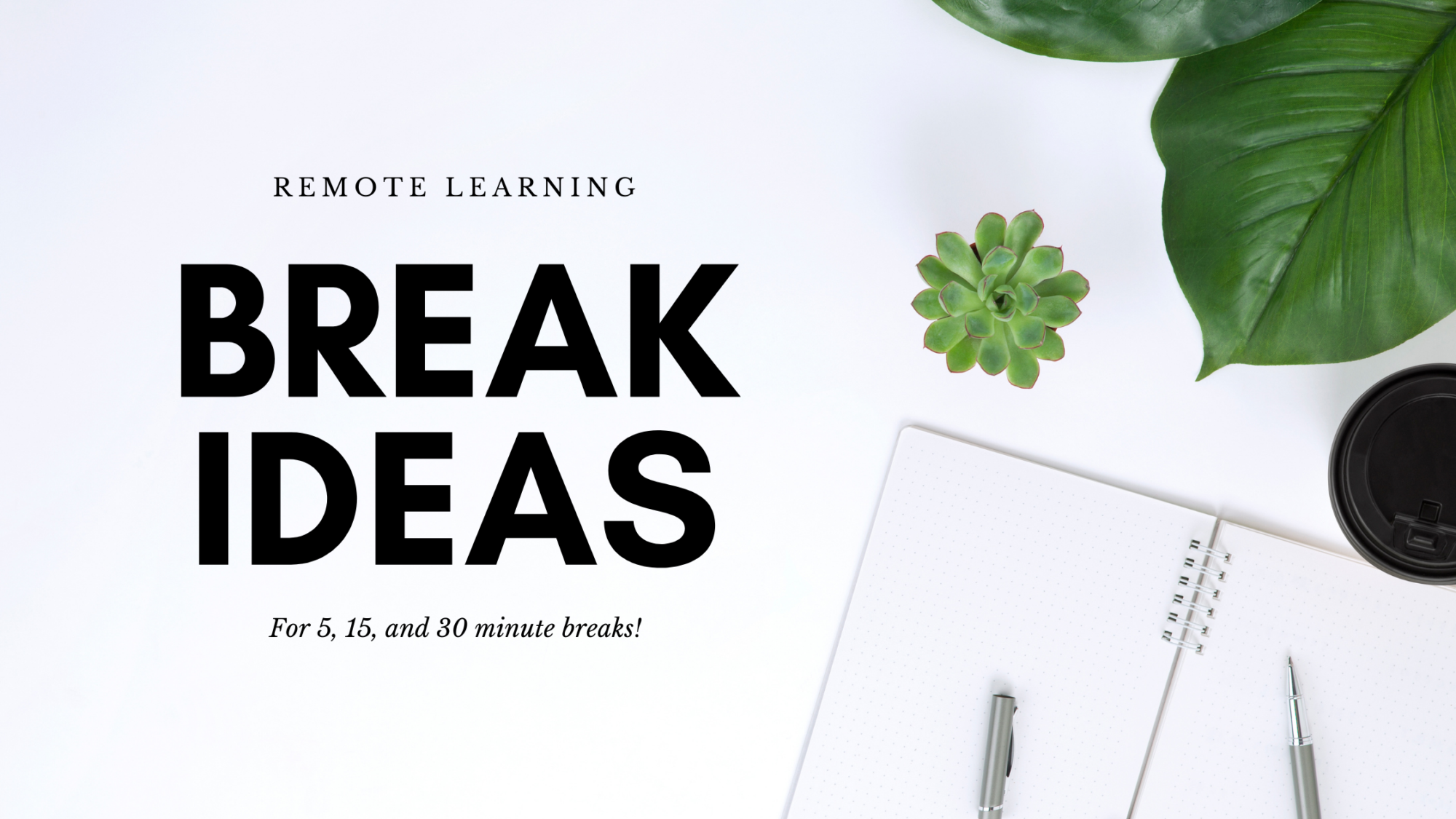Learning looks very different for most children since the coronavirus pandemic began. For children who are doing virtual learning, they may be sitting in front of a screen for many hours each day. This extended screen time often leads to difficulties in sustained attention and staying on task.
Short, planned, screen-free breaks can help children clear their minds, move their bodies, and provide an overall reset to support continued engagement in remote learning. Print out this bonus visual list of our virtual learning break ideas for your child to keep near their desk!
Get the most out of your child’s virtual breaks
- Make a plan in advance with possible break activities and have materials prepared ahead of time.
- Consider what your child responds best to and what type of break your child needs in that moment. For instance, do they need to relax or move their body?
- Use a timer to ensure your child’s break lasts the right amount of time. Make sure your child can see the timer to help prepare them for when it’s time to get back to work.
5 minute remote learning break ideas
- Yoga – Get their body moving, while helping your child relax their mind and body.
- Deep breathing – Practice different deep breathing exercises to help instantly decompress (ex. Have children visualize colors while focusing on their breath; inhale a cool, calm blue and exhale a hot, intense red).
- Pop bubbles – Blow bubbles and instruct your child to pop the bubbles in different ways (ex. scissor fingers, clapping hands, pinkies only).
- “Beat the clock” exercises – Engage in quick cardio exercises to get the heart pumping (how many jumping jacks can you do in 30 seconds, run to the mailbox and back as many times as possible in 1 minute).
- Eye Spy – Take turns playing Eye Spy in different rooms of the house, or even outside.
- Follow the Leader – Move around the house, or outside, in easy and fun ways (high march, tip toes, skipping). Take turns in being the leader.
- Just Sit Still – Challenge your child to spend two minutes just sitting, or lying, still with their eyes closed. It’s amazing how easily this can reset the mind! For younger kids, try it for one minute first.
- Stretching – Engaging in big stretches can be practiced standing or while your child remains seated.
- Letter Guess – Use your finger to “draw” a letter on your child’s back and have them guess which letter it is. Switch when your child guesses the letter correctly. Try mixing in upper- and lowercase letters to make it more challenging!
15 minute remote learning break ideas
- Dance party – Put on your favorite songs and have a dance party. Signing along encouraged!
- Playdough – Let your child create something of their choice or just squish some playdough around.
- Scavenger hunt – This can be as simple as having your children find an item that starts with the letter “D” or something that is soft.
- Play catch – Head outside to toss a ball around or use a rolled-up pair of socks inside.
- Color – A relaxing, creative break in which your child can use a coloring page or draw their own picture on a blank sheet of paper.
- Puzzles – Offering jigsaw puzzles, which your child can work on a little bit each break, or brain teasers can offer your child a fun challenge.
- Balloon Volleyball – Blow up a balloon and then take turns passing it back and forth without letting it touch the ground. For a challenge, add an extra balloon and see if you can pass them both at the same time or make a rule that you can only touch the balloon in a certain way (ex. with your pointer finger or your elbow).
- Alphabet Game – Choose a category (ex. food, animals, sports teams etc.), then take turns naming something from that category while going through the alphabet. For example, if your category is food, one person might say “apple pie,” the next person “bread” and so on.
30 minute remote learning break ideas
- Go Outside – Prioritize time for your child to get outside and to move their bodies whether it’s by going on a family walk, riding bikes, jumping rope, or playing games like hide-and-seek.
- Building – Let your child in build freely or give a challenge (ex. build the tallest tower they can) with blocks, Legos, or items found around the house.
- Sensory Bin – Sensory bins are a popular option with children which can be created using water beads, kinetic sand, or with rice, pasta, and beans. Items in the box can be changed as often as you’d like to keep your child engaged and stimulated.
- The Floor is Lava – Get your children laughing and moving while pretending the floor is lava and cannot be touched. Stay off the floor by using cushions, furniture, or other household objects.
- Read a Book – Offer quiet and relaxation by reading a book to your child or having them read/look at books of their choice independently.
- Water Color Painting – Engaging in art gives your child the opportunity for relaxation and creative expression. Try putting on some relaxing music in the background.
- Play a Game – Connect with your child while playing a card game (like Go Fish, Old Maid, or Uno), boardgame (like Sorry, Monopoly, or Candyland), or other game (like Jenga or Connect Four). If the break is over before the game, save the game for later when you can finish playing.
- Play with Favorite Toy – Encourage your child to play with their favorite non-screen toys.
For more virtual learning tips check out A Child Therapist’s Top 3 Tips for Virtual Learning and Independence during virtual learning!

